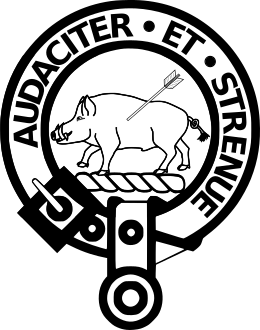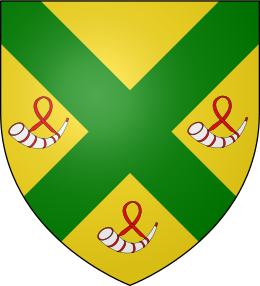Clan Pollock facts for kids
Quick facts for kids Clan Pollock |
|||
|---|---|---|---|

Crest: A boar passant shot through with a dart Proper
|
|||
| Motto | Audacter et Strenue (Boldly and earnestly) | ||
| Profile | |||
| Region | Lowlands | ||
| District | Renfrewshire | ||
 |
|||
| Clan Pollock has no chief, and is an armigerous clan | |||
| Historic seat | Pollok Castle | ||
|
|||
|
|||
|
|||
Clan Pollock is an old Scottish family group, or clan, that doesn't have a chief today. Their story began in the 1100s. Back then, the sons of a knight named Fulbert were given land by King David I and Walter fitz Alan, who was a very important person called the 1st High Steward of Scotland. This land was on the south side of the River Clyde in Scotland. The Pollock name is one of the oldest family names ever recorded in Scotland! The clan is also connected to Clan Maxwell.
Contents
The Story of Clan Pollock
How the Clan Began
The Pollock clan's history starts with a knight named Fulbert. He was a loyal follower, or vassal, of Walter fitz Alan. Fulbert came to Scotland around 1136 from Oswestry, Shropshire, England. He even fought for Scotland in a big battle called the Battle of the Standard in 1138.
Because of Fulbert's service, his sons were given land in an area called Renfrewshire. This gift of land was officially confirmed in a special document, or charter, by King Malcolm IV in 1157. You can still find the family name in places like Pollok, Pollokshields, and Pollokshaws. These places are all located south of the River Clyde, between Glasgow and Paisley.
Important Moments in Clan History
In 1163, Petrus de Polloc, who was Fulbert's oldest son, gave the church of Pollock to the monks at the Priory of Paisley. Petrus also gave a large area of land called the Barony of Rothes to one of his daughters as part of her dowry (a gift given when marrying). Robert de Polloc, Fulbert's third son, also gave the church of Mearns to the Priory of Paisley.
Later, in 1296, a man named John de Polloc signed the Ragman Rolls. This document showed his loyalty to King Edward I of England.
Centuries later, John Pollok of Pollok supported Mary, Queen of Scots, in the Battle of Langside on May 13, 1568. This battle happened very close to Pollock Castle. Because he supported Queen Mary, John Pollok lost some of his lands.
His son, also named John Pollok, was involved in another conflict. He was killed on December 7, 1593, at the Battle of Dryfe Sands. This battle was a fight between Clan Maxwell and the Clan Johnstone.
In 1703, Robert Pollok of Pollok was recognized for his service to the crown. Queen Anne made him a knight and the first Baronet of Pollok. A Baronet is a special title, like a hereditary knighthood.
Clan Symbols
- Clan Chief: Today, Clan Pollock does not have a chief. This means it's an armigerous clan, which is a clan that has official symbols but no recognized leader.
- Chiefly Arms: The clan's coat of arms shows a green X-shape (a saltire Vert). The second, third, and fourth sections have gold bugle horns with strings and decorations.
- Motto: The clan's motto is "Audacter et strenue." This Latin phrase means "boldly and earnestly."
- Crest: The clan's crest shows a wild boar that has been shot with an arrow.
- Tartan: Clan Pollock has two main tartan patterns: Pollock Ancient and Pollock Modern.
Clan Castles
- Pollock Castle
Special Titles
- Barony of Rothes (from the 1100s)
- Baronets of Pollock (a title created in 1703)
See also

